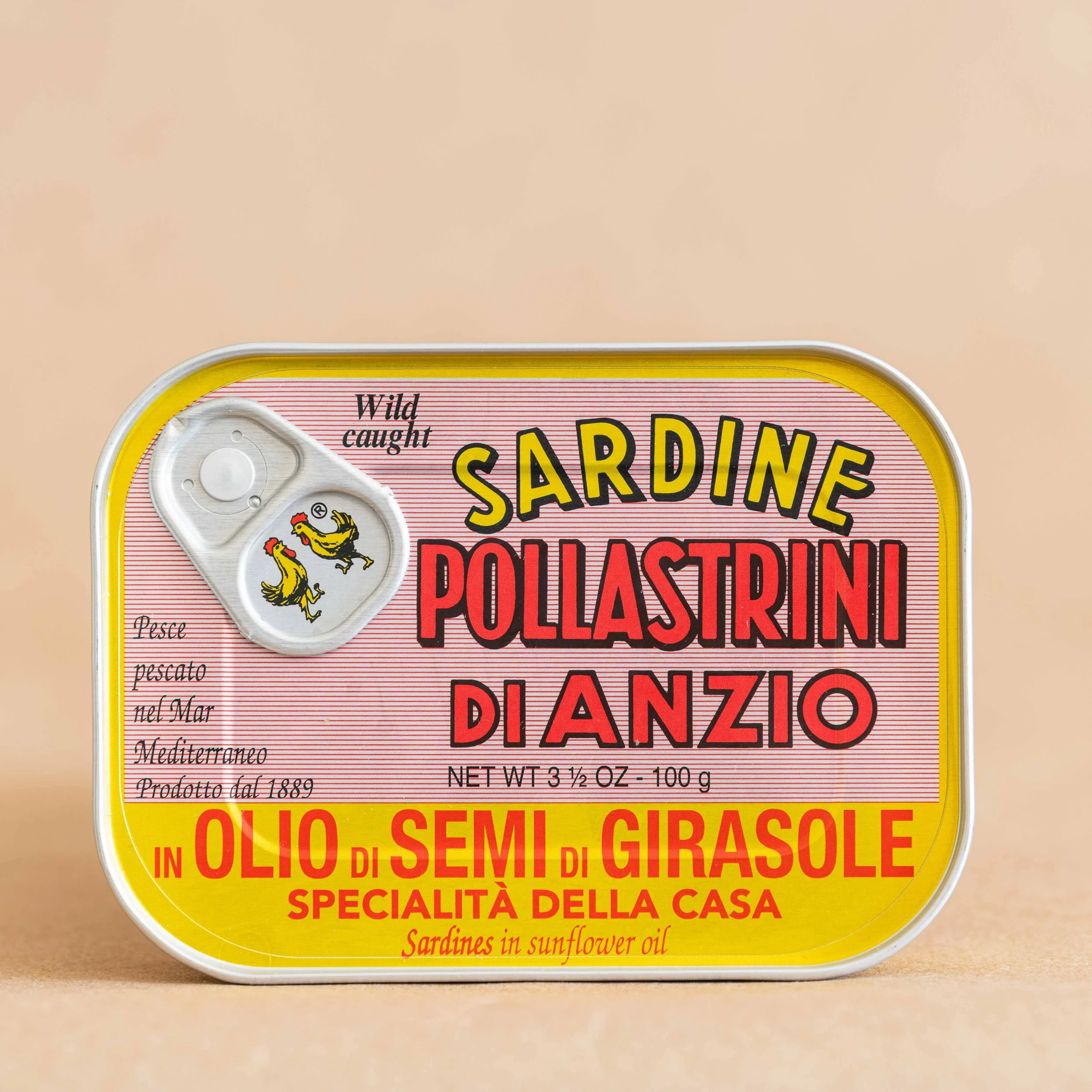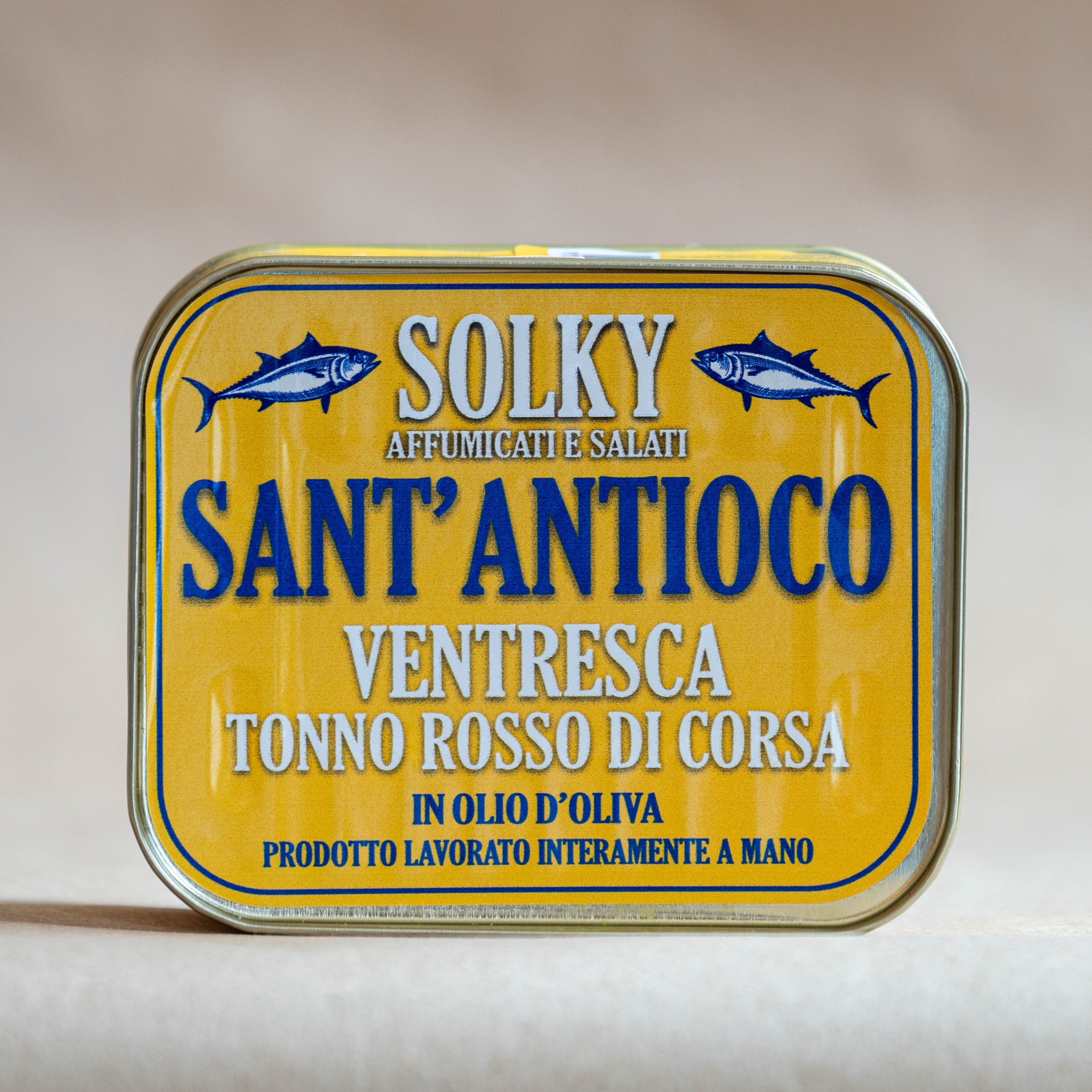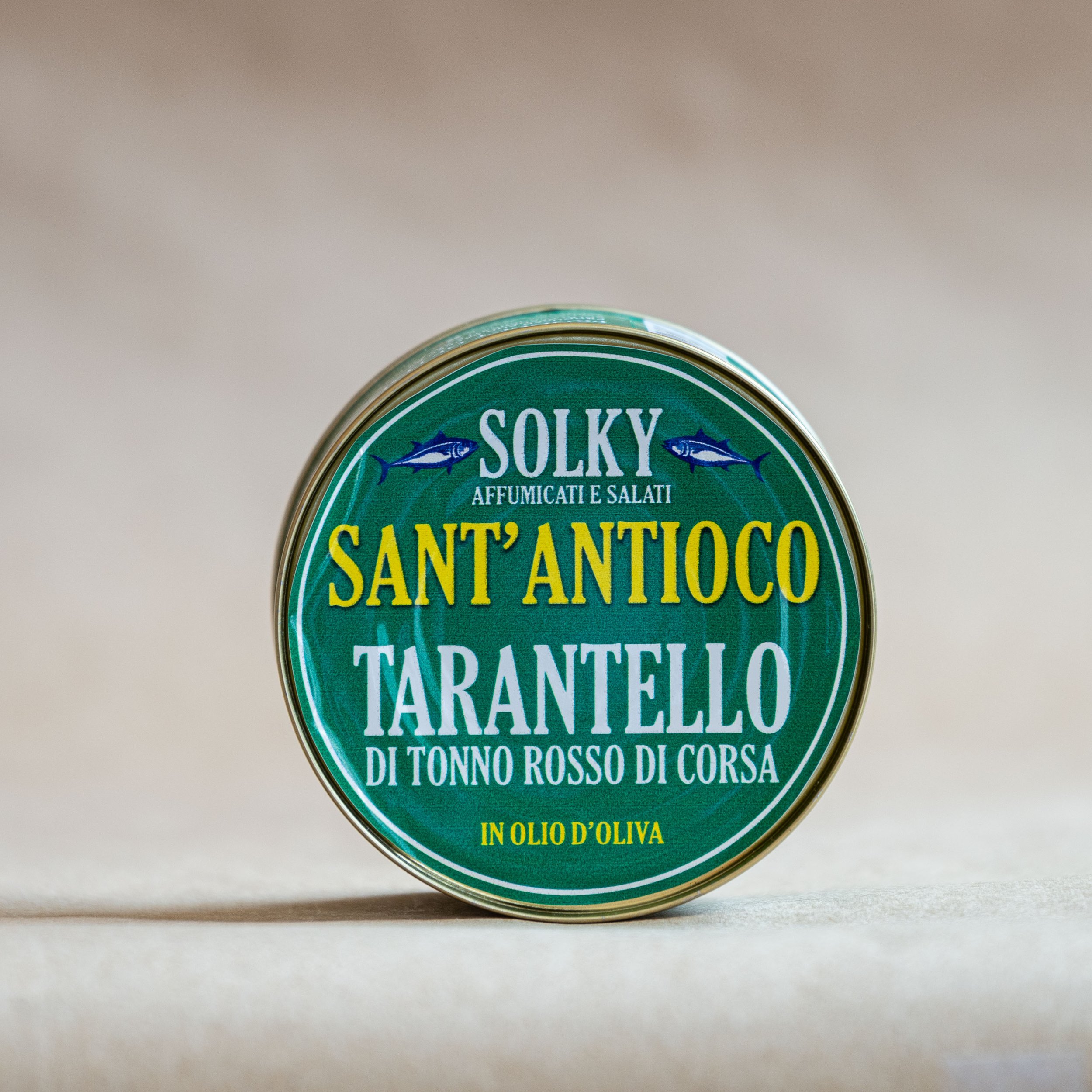Pollastrini: Anchovies & Sardines
Where: Anzio, Lazio, Italy
Who: Elena and Andrea
What: Tinned sardines and anchovies
Key fact: A family-owned and operated cannery dedicated to sustainable fishing practices. They are the only Italian cannery of Mediterranean sardines.
Website: pollastrinitalia.it/en
Italy’s last remaining sardine cannery hides on the back side of a massive old warehouse in working class coastal Anzio. Signs for some frozen seafood companies dot the thoroughfare alongside it. Elena and Andrea protect a family tradition that started in the 19th century. Their canning equipment is large but simple, requiring lots of hand work by skilled locals. Their fish are caught only in the Mediterranean, using traditional small boat methods. They fish in the proper seasons for anchovies and sardines, ensuring fat, flavorful little fishes. Elena was excited to show us the diligence of their traditional system of work. I don’t think Pollastini gets many visitors! While the cannery is a small operation functioning within the exoskeleton of its former heyday framework, I have reason to believe Elena and Andrea kept the canning lines moving just long enough. Global tastes have returned to favor delicious, affordable, sustainable and healthy sardines. Pollastrini deserves a share of this renaissance.
Since Roman times, Anzio has been a significant fishing port on the coast of Lazio. Pollastrini are distinct. They still fish using the traditional Thyrennian gozzo small fishing vessel, and catch sardines at points in the season when their meat is richest. Pollastrini use 100% recyclable packaging.
I found little solace while exiled to the culinary wasteland of 1980’s England. Its horrors have been exaggerated, but only just. Amid chip butties, ploughman’s lunches, and sad soupy curries, sardines became an item of interest. A cheap tasty protein, a quick sandwich, an intriguing flavor.I was hooked. In adulthood, friendships developed discussing and sharing the joy of tinned fish.
Canned sardines have entered the culinary zeitgeist. I’m fine with it. I’m glad they’re having a moment in the sun.
Pollastrini Anchovy Filets in Olive Oil
100g tin
Salty! Loosely packed (intentionally) to facilitate absorption of the oil. The filets are a very pretty color, rich red. Nice flavor. Some bones.
Pollastrini Spicy Anchovy Filets
100g tin
These slightly larger anchovies should be the base of every sugo you make. I’ll toss them on Ooni pizzas to ward off feral children eyeing my dinner. Or, to convert those adolescents to the unwavering happiness that is fishy umami.
Pollastrini Sardines in Olive Oil
100g tin
Finger-length filets, tender and mild. A lovely flavor that I believe would make this tin a great entry-point for diners eager to explore the appeal of sardines. Markedly not “fishy” whatever that means.
Pollastrini Spicy Sardines
100g tin
Ahoy, chili oil! Moderately spicy, the type of heat that builds with each nibble. In 2025 Pollastrini caught these fish off the coast of Croatia, and tinned them at a facility in that country. It made more sense to preserve them on the Adriatic coast, instead of hauling sardines all the way back to Lazio. Freshness is everything, even in tinned fish.
Pollastrini Sardines in Sunflower Oil
100g tin
Pollastrini Vintage Sardines in Olive Oil “Millesimate”
100g tin
Yes, sardines can age. Europe's best canneries sometimes release their top tinned fishes with a vintage date. In my experience, 4-5 years of time in a can will give sardine flesh a nicer texture. As in wine, secondary flavors emerge, and the distance between boring cheap meat and the flavorful snack of your dreams widens. Don’t believe me? Stash a few tins in a cool dark place. Food experiments are fun.
Pollastrini 2021 Vintage Spicy Sardines “Millesimate”
100g tin
Nice white flesh, pretty skin. Dense dry texture. Pleasantly spicy. Medium size.





Solky Affumicati e Salati : tuna
Who: Fernando Antioco Fois
Where: Sant'Antioco, an island off of Sardegna, Italy
What: Hook and line-caught Bluefin and Yellowfin tuna packed in olive oil.
Key fact: A small cannery to the South West of Sardegna. They fish only during the month of May, when tuna is migrating but not quite reproducing. The meat is fatty and rich in nutrients.
Drop everything you are doing and buy this tuna. Two blocks away from the coast of this tiny island, southwest of Sardinia, Antioco Fois makes tinned fish. His storefront is a few rooms, and a big cooler. He works with three other men, to jar smoked eels from the lagoon, process bottarga from mullet, and (of fundamental importance) take apart and tin 20 large bluefin tuna (on average) per year. Very large fish: 200kg average.
This island (and Carlo Forte, the larger neighboring island) are famous for tinning tuna, because a happenstance of geography and migration patterns take the fish at the optimal point in their growing season close to this shore. They are funneled into a narrow channel of water where, even centuries ago, fishermen in small boats could line-catch them.
You’ll never taste better tuna. I’m a diehard canned fish fan. A first encounter with Solky’s jarred tuna at a shop in Parioli six years ago changed the trajectory of my work life, and led us to this point.
If you value food artisanship, you must explore Solky. It’s one of those emotional resonance places I was talking about earlier. Visit Antioco Fois and you’ll spend a decent amount of time biting your tongue to hold back tears. Not only due to unmissable natural beauty, and a realness that even the hardest of hearts can feel. The man is doing something the right way: creating a real thing. It’s his identity, and the place’s, and has been like this for a very long time.
We ate lunch in a cinder block restaurant on the shoreline, the kind of place you’d drive past 100 times and never stop. Tiny sign, washed out yellow paint, a cluster of locals inside keeping warm next to a wide narrow fireplace where meat is grilled. The food was of course phenomenal: earthy beans, grilled eels and tiny fish (like sardines) plus fritto misto, and pasta. We drink a liter of white wine from a plastic jug. It was great. Antioco drank mirto after the meal, a local berry distillate. I had espresso. I needed a nap.
Bluefin Tuna in Olive Oil
160g tin
This is the super-solid "normal" bluefin tuna from Solky. Not the coveted back and belly, but the rest of the fish. It's the red tin. The bulk of what I buy personally will be this product.
Bluefin Tuna in Olive Oil
350g tin
Sometimes grams are hard to visualise. This is a big tin. You can’t eat this in one serving. As a component of a Nicoise salad, I’d say it serves six. This is the super-solid “normal” bluefin tuna from Solky. Not the coveted back and belly, but the rest of the fish. The bulk of what I buy personally will be this product.
Yellowfin Tuna Fillets in Olive Oil
300g jar
This is the product that lured me into Solky’s universe. The snazzy packaging caught my eye. It seemed worth hauling home, risking a suitcase disaster. The yellowfin tuna is packed in really high quality oil. Antioco stressed that every tin/jar contains several euros of EVOO oil: don’t throw it out! The freshness of all Solky tuna hews closer to cooked fresh fish than it does to run-of-the-mill canned tuna.
Bluefin Tuna Dark Fillets in Olive Oil
350g tin
This is Buzzonaglia. I love euphonious Italian language. Say this word out loud, and you get a sense of how it’s regarded among fisherfolk. This is the part of the meat that surrounds the backbone of the fish. The meat is flavorful, less refined, really great for hearty red sauce pastas with olives and capers, and stuffing into red peppers. It’s not bland. Buzzonaglia is miles more delicious than supermarket tuna.
Bluefin Tuna Belly Fillets in Olive Oil
160g tin
This is Ventresca. It is my favorite. It tastes luxurious. This is special occasion tuna. Your conserva-loving friends and family will freak out for this tin.
Bluefin Tuna Belly Fillets in Olive Oil
350g tin
Dionysis of the seas would eat ventresca with joyous abandon. The fattiest of fish belly, meat that seems to melt away on the palate, a joy for all senses. Do you love unbridled happiness? Can you give into sheer gustatory bliss? If so, ventresca is your desert island tuna.
Bluefin Tuna Back Fillets in Olive Oil
160g tin
This is Tarantello. It’s the favorite piece of the tuna of Antioco Fois. We’ve translated it as “back” but it’s really a filet just behind the Ventresca “belly.” It’s less fatty, more meaty.
Bluefin Tuna Back Fillets in Olive Oil
350g tin
Much debate around which piece of tuna is the finest starts with tarantello, or tuna back. The flavor is superior to other parts of the fish. And there’s real tenderness to this meat. If I had to pick one Solky item to prove to a stranger that it’s worth paying real money for superior tuna, this would be my tin of choice.















